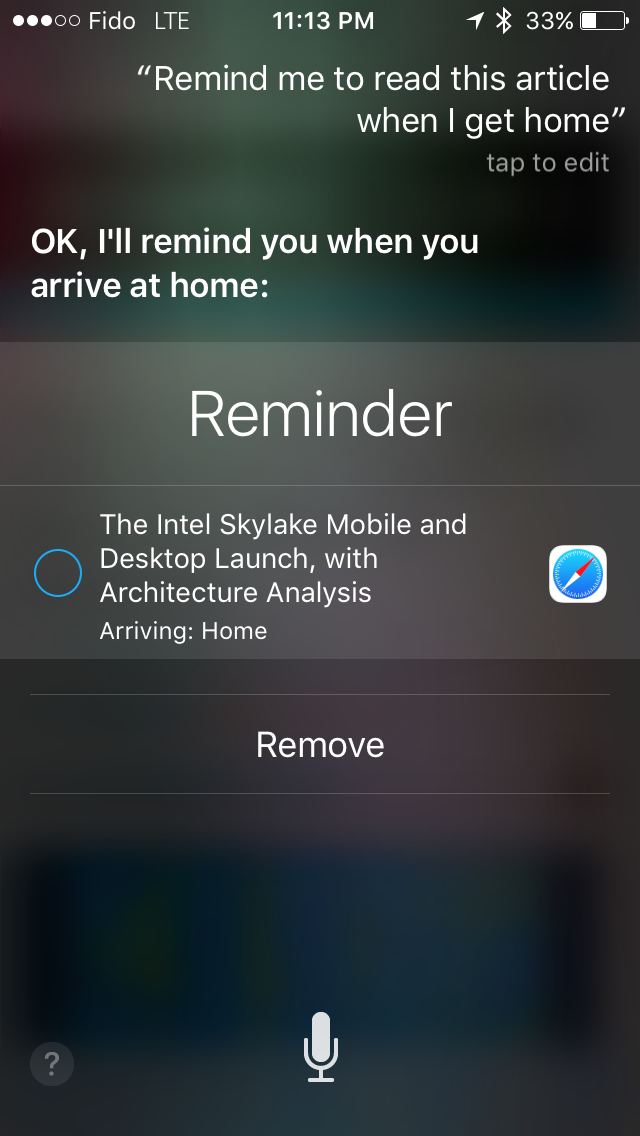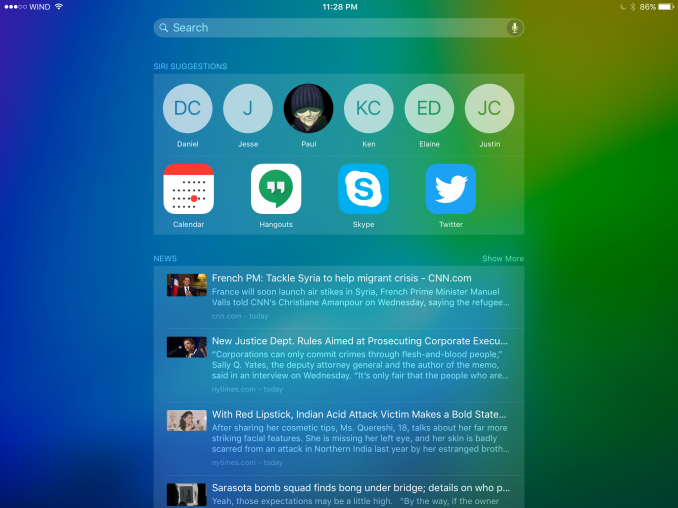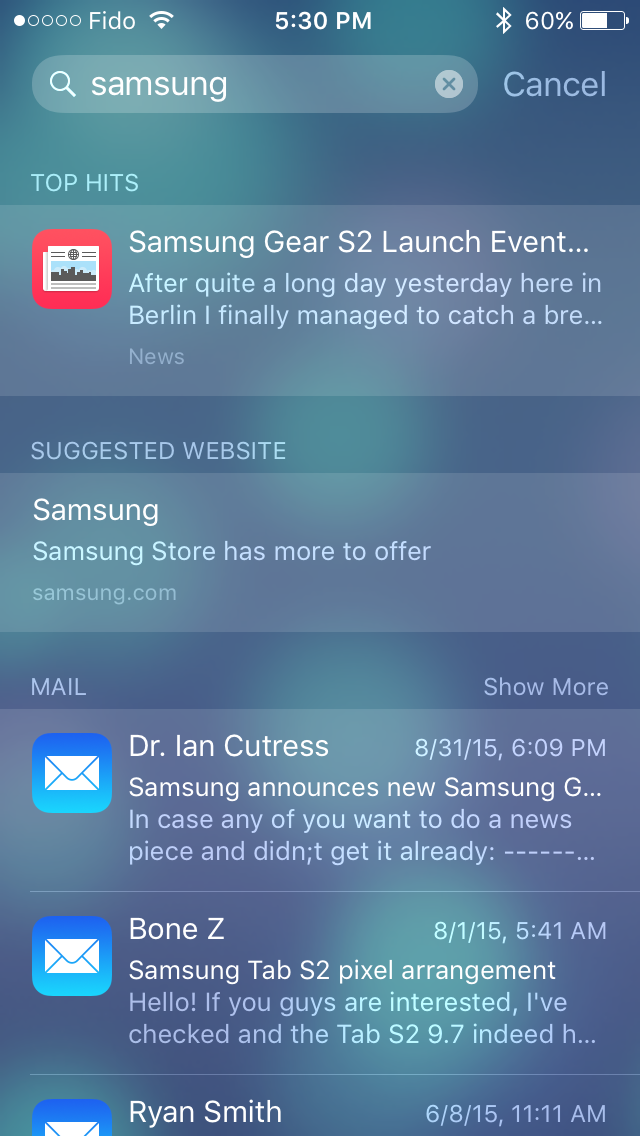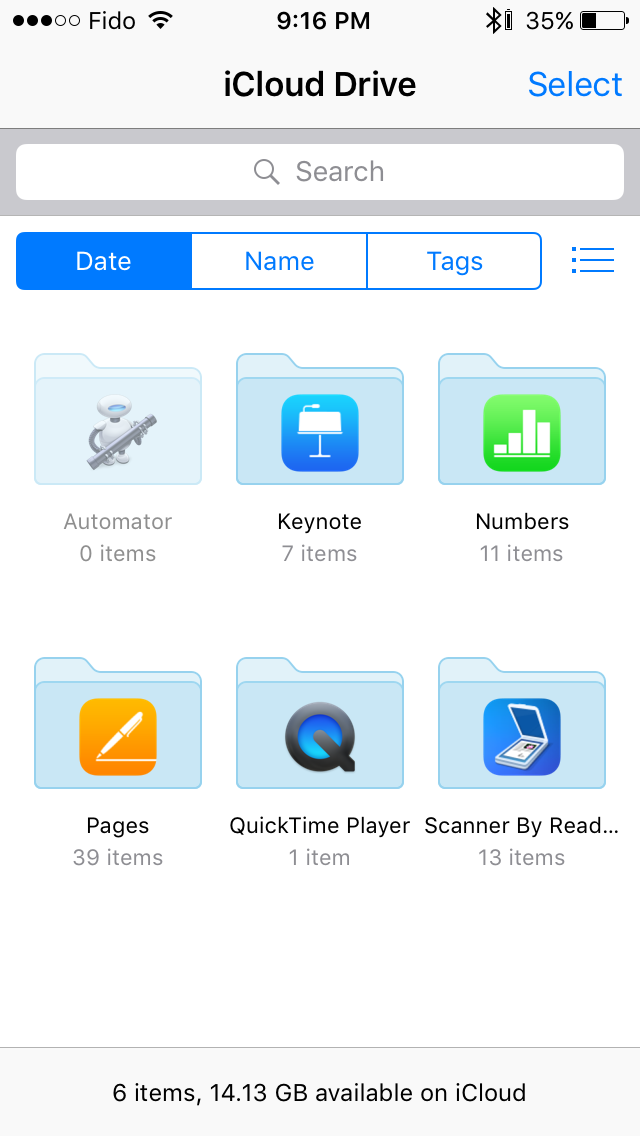The Apple iOS 9 Review
by Brandon Chester on September 16, 2015 8:00 AM EST- Posted in
- Smartphones
- Apple
- Mobile
- Tablets
- iOS 9
Siri
Siri debuted with iOS 5 on the iPhone 4s, and at the time was really the first virtual assistant integrated into the core of a mobile OS. It has faced steady competition from Google Now and now from Microsoft's Cortana, and in my experience it seems that Google Now still holds an advantage as far as speed and accuracy goes. However, at WWDC 2015 Apple detailed a number of statistics relating to Siri, and showed how Siri is being improved in iOS 9. According to Apple, Siri serves over one billion requests every week, and has gotten 40% more accurate in the past year, with a word error rate of just 5%. Siri has also gotten 40% faster in the last year, and having tried using Siri again for the purposes of this review it does seem that it has improved in these respects.
iOS 9 focuses on making Siri more intelligent and proactive. Part of this just involves simple improvements, such as how conversions are now done natively instead of referencing Wolfram Alpha, which ends up being much faster. In other cases, the fact that Siri is more aware of context allows for new uses that weren't previously possible. You can see above how asking Siri to remind me to read an article created a reminder which would have an embedded link to the webpage I was reading when it reminds me after I arrive home. You can also use Siri to make specific searches, like looking for photos based on a time and location. However, the contextual awareness doesn't go near as far as Google Now on Tap which will be launching in Android M and will allow you to ask questions in natural language about the content you're viewing and get relevant answers.
Ultimately the local and front end improvements to Siri as a voice assistant are not enormous, and the real improvements are those that Apple continues to make on the back end to make Siri more accurate and responsive when you use it. Since these improvements have nothing to do with the timeline of iOS releases - a consequence of Siri being as much a service as it is an OS function - there's not much I can say about them beyond what Apple has said. However, Siri has been expanded in iOS 9, and has now taken over what was previously Spotlight Search. The new search screen and enhanced universal search on iOS are what I'll look at next.
Universal Search
iOS 3 brought Spotlight Search from OS X to the iPhone. It was a screen you could access by swiping to the left of your first home screen, and it allowed you to search for applications and a limited set of content on your device. With the iOS 7 redesign this screen was eliminated, and Spotlight was now something you accessed by swiping down on any home screen. iOS 9 changes things up, and in a case of what you might call indecision Apple has decided to put a search section both in the old Spotlight Search area, and the screen accessed by swiping down on a home screen. However, this new search section to the left of your home screens has a couple of new features which are worth mentioning.
In addition to having search, the new search screen displays suggestions from Siri for apps you may want to open or contacts you want to call or send a message to. My problem is that I don't understand the reasoning behind the suggestions that I'm being given. The contacts seem to be chosen well, but only because I only contact four or five people frequently. The apps just seem nonsensical. I am very sure that I have never opened the YouTube app at 12:30AM in my entire life. The news selections are also terribly irrelevant. That isn't to say that all the stories themselves are irrelevant, but considering the fact that the majority of my Apple News sources are technology related I would love to know why I have never ever seen a single technology article in this list.
As for the searching itself, that's where things improve. Search has been given the same upgrades as Siri, with support for making conversions. You can also do voice searches which is a long overdue addition. Searching for general terms is also greatly improved. For example, searching for Samsung gives me the Samsung website as a suggested site, news from Apple News, general results from Bing, apps from Samsung on the App Store, Samsung's Wikipedia page, contact suggestions from people at Samsung that I've sent emails to, and even more. This is honestly the level of depth that search should have had on iOS for a long time now, and it's great to finally have a reliable way to search for something on the device with only a simple search term.
With iOS 9 Apple is also providing a search API for developers, which will allow them to add their own applications to the sources that are searched through. This means that an app like Twitter could allow you to search for tweets that you favorited or retweeted using the built in iOS search bar, and Microsoft Office could show you a document based on your search for a phrase that is inside it.
Search is definitely an area where iOS has been lacking for a long time now, and the additions Apple is making in iOS 9 are welcomed but definitely overdue in many cases. I think being able to search through many applications is great, and the integration with Siri to provide results like contact suggestions can be very helpful. At the same time, I really think the screen to the left of the home screens is poorly thought out and not useful because you can access search itself from any home screen. I feel like there was an initiative at Apple to create some sort of competition for the Google Now card screen, but it really didn't turn out well.
iCloud Drive
This is more of a power user app, and it's put in the OS somewhat like an easter egg. Basically there's an application that lets you view, download, and open files stored in iCloud Drive. The UI is essentially just the iCloud Drive picker put into an app with some changes, and you can see it below.
There's really not much to say about the app. Everything is organized the same way iCloud Drive is in Finder on OS X and on the iCloud website. You can download files, move them to different folders, and open them or copy them to an application of your choosing. It's just something to make note of if you ever want to manage your drive from your iPhone or iPad.

















227 Comments
View All Comments
Wolfpup - Wednesday, September 16, 2015 - link
Good/interesting question.So weird to think the iPad 2 seemed all-powerful (for a mobile device) just a few short years ago. :-D
Peichen - Wednesday, September 16, 2015 - link
Looking forward to try it out on my new 6S+. I do wish with the bigger RAM Safari would let me cache more sites so I can read them on the train.Wolfpup - Wednesday, September 16, 2015 - link
Can you use that reading mode? I think you can save stuff to read offline, stores it to flash. That seems like it would be what you want.(I'm not 100% sure about this as I don't really have a use for that mode, but that seems to be what it does.)
Klug4Pres - Wednesday, September 16, 2015 - link
Congratulations to the reviewer on finally addressing the RAM situation with some serious analysis - long overdue!iwod - Wednesday, September 16, 2015 - link
I am wondering why it still take 60MB for a Twitter Client. Even the Pinterest 35MB is huge in my opinion. Since most of the heavy lifting are done in the OS already. I was expecting these apps to be within 20 - 30MB range.And the people who are complaning about the review are the ones who also complain about the recent Apple Pencil. Whenever we are on the topic of Apple, there are basically two types of people,
Those who don't understand Apple, and those who misunderstand Apple.
Pissedoffyouth - Wednesday, September 16, 2015 - link
I still don't know why Whatsapp needs 100mb+ on my phone eitherKepe - Wednesday, September 16, 2015 - link
Probably because all the images and videos your buddies send are stored on your device and counted as part of the app's total size. If you're on Android, go to settings -> apps -> Whatsapp and clear Data. A fresh install of Whatsapp is 24MB on my phone.danbob999 - Wednesday, September 16, 2015 - link
Twitter needs to be 60MB for two reasons:-1MB for the twitter client
-59MB to spy on you
tipoo - Wednesday, September 16, 2015 - link
Argh, I didn't know content blockers will only work on ARMv8. Bummer, A5 and A6 need them most.Wolfpup - Wednesday, September 16, 2015 - link
I gave up on both Google Keep and Apple’s Notes, as in my experience neither syncs reliably.I’ve ended up using Google Docs for notes, as it pretty much does sync fine…weird since it’s also from Google.
“What would have been optimal for RAM would be if Apple had moved to 2GB with A7 to offset the additional memory usage of 64bit applications, and moved to 4GB in the next generation iPads (Air 2, future devices) to accommodate multitasking”
Absolutely! I really thought the iPhone 5s/iPad Air should have shipped with 2GB…for years now I’ve felt Apple’s been shipping virtually every iOS device with half the RAM it should have, and I was utterly stunned when even the iPhone 6 continued shipping with only 1GB.
The original Surface 1 (ARM) has similar specs to the iPad 2 in terms of CPU/GPU, but 4x the RAM, and runs a desktop web browser (and office suit for that matter). It’s VAAAAAAAAAAASTLY more useable than dealing with mobile Safari and “multitasking” as it exists on iOS. This all sounds like a huge upgrade in iOS 9, but still, the limited RAM and way it’s implemented…oh well, it’s still a step forward.
I can see using remote desktop + Safari, or Safari + Mail at the same time on a iPad Pro as being a vastly superior experience to what’s available now on iOS, at least assuming this all works fairly decently.
On my iPad now, I literally half the time just remote in to a Windows 8 system to take advantage of the real multitasking (and file system) as it’s soooo much faster than slooowly loading a program, slowly switching, having the first program have to reload, tabs having to reload constantly, etc., etc., etc.
Regarding the back button issue, I STILL don’t really “get” having a system wide back button in Windows Phone and Android. The way it works isn’t consistent, and I still find it more confusing than just implementing a UI however you want it in your own program. I mean even with a back button that’s still what’s going on, as I’m often unsure (aside from just remembering on a case by case basis) what “back” is going to do at any given time. The back link sounds like it’ll be useful, maybe.
The “Safari view controller” sounds great, fixes some issues I’ve had, and I appreciate that it’s sandboxed from the host program that invoked it, though of course there’s the security \issue that you might not KNOW whether you’re in Safari or in the program proper.
Regarding “app thinning”, I wonder what happens with iTunes? Does iTunes get ALL the resources, and then sync all of them, or do the “thinning” when syncing to a specific device?
And there’s “GPU low/high”…but what happens as we get new GPUs in the future? I mean do “low/high” kind of correspond to specific GPUs? Will there be a “high 2”, etc. down the line?
I wonder too what happens to programs already installed? Do they have to be deleted and redownloaded from the store (or presumably when they get updated) to get “thinned”, and for that matter, what happens when you download something on an iOS device, and it syncs back to iTunes on a PC?
The “on demand resources” thing sounds idiotic. I don’t likes it!
The “bitcode” thing is a nifty idea though (though once again raises questions regarding iTunes).
Hmm…this does mean theoretically the 32GB on the iPad Pro should go a bit further than 32GB under iOS 8…